Last Updated on January 12, 2024 by Greg Gillson
Did you see a brightly-colored red bird, orange bird, or yellow bird in New York and wonder what is was?
This page is for you!
This article shows you photos and identification of some of the most common birds in New York based on color.
The list of birds found in New York includes over 500 species. I’m going to assume that you saw a common bird of this color, but you certainly could have seen something less common, or even rare!
Shape (including the shape of the bill) and size are often more helpful in starting to identify a bird than the color. In fact, most birds in North American can be easily identified with a black-and-white photo!
Many birds are multi-colored, so that it may be hard to pick out a dominant color. Males and females may be colored quite differently. And some color patterns are similar among otherwise dissimilar species.
Nevertheless, I’m going to try to pick out some of the birds that you are most likely to see in backyards or towns. And I’ll show a few others that I get asked about a lot.
The birds with a noticeable amount of red on them in New York covered in this article are:
- Rose-breasted Grosbeak
- American Robin
- Northern Cardinal
- House Finch
- Ruby-throated Hummingbird
- Purple Finch
- Scarlet Tanager
- Common Redpoll
The birds with a noticeable amount of orange on them in New York covered in this article are:
- Barn Swallow
- Ruddy Duck
- Baltimore Oriole
- Eastern Towhee
- American Redstart
- Red-breasted Nuthatch
- Wood Thrush
- American Kestrel
- Brown Thrasher
The birds with a noticeable amount of yellow on them, including lots of yellow and black birds, in New York covered in this article are:
- American Goldfinch
- Northern Flicker
- Common Yellowthroat
- Yellow Warbler
- Cedar Waxwing
- Yellow-rumped Warbler
- Great Crested Flycatcher
- Magnolia Warbler
- Yellow-throated Vireo
Red birds of New York
Birds get the red, orange, and yellow in their feathers from carotenoids in the fruit, seeds, and plants they eat (source).
These carotenoid colors combine with melanin to form an infinite range of red feathers–pink, rusty, scarlet, violet, red-orange.
The following are red birds that you are most likely to see in New York.
Rose-breasted Grosbeak
These birds with the red breast and huge pink bill sing beautiful robin-like songs from the tops of trees.
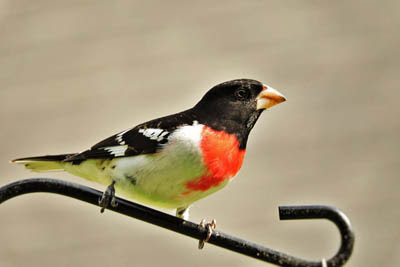 |
| Male Rose-breasted Grosbeak. Susan Killian. Pixabay. |
Males have black hood and upper parts. White under parts. Large white wing patches. Huge pink bill. Inverted bright red triangle on the breast.
Females are brown above, face with broad stripes, white throat. The under parts are buff with many thin brown streaks. Pale bill.
These birds inhabit deciduous and mixed forests. Shade trees in town. Come to feeders.
Rose-breasted Grosbeaks are summer residents throughout New York.
American Robin
These are familiar lawn birds with red breasts.
 |
| American Robin. Greg Gillson. |
Male American Robins are brownish-gray above with a brick red breast.
Females are paler orange below and paler gray above.
They are widespread in open country with scattered deciduous trees, residential areas.
American Robins are year-round residents throughout most of the lower elevations of New York, summer residents only in the higher parts of central and northeastern New York.
Northern Cardinal
These are one of the most common backyard birds in the eastern United States. Their bright red color and unique head profile makes them instantly identifiable to most people–whether they are bird watchers or not!
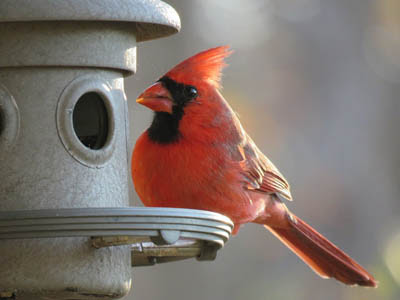 |
| Northern Cardinal. GeorgeB2 from Pixabay. |
Males of these large seed eaters are bright red with a black face and red crest.
Females replace most of the red with brown, The bill is large and orange.
These birds are found in woodlands, stream edges, residential areas.
Northern Cardinals year-round residents throughout New York.
House Finch
When people ask about a bird with a red head at their feeder, it is usually this bird.
 |
| Male House Finch. Greg Gillson. |
Males of this dusty brown striped finch have red limited to the head (specifically the forehead and eyebrow), breast (chest), and rump. The red coloration tends toward orangish, and may rarely be yellowish.
Females are streaked, similar to the males but without red. They lack any strong pattern on the face and head.
Note the small round head and curved upper ridge on the bill.
Some people call these red-headed sparrows. Sparrows and finches are similar, but in general, male finches are brighter than the females and tend to hang out more in trees. Sparrow genders are usually quite similar in coloration and tend to feed mostly on the ground.
These birds are common in residential areas, especially at bird feeders. In the West more widespread in arid regions near water.
House Finches are year-round residents throughout New York.
Ruby-throated Hummingbird
These red-throated birds are the only hummingbird nesting in the eastern United States.

Males are dark green above and on the belly. They have a white upper chest. The throat is ruby-red.
Females are green above, white below, including white throat.
These birds are found in woodland edges, residential yards. Readily come to hummingbird feeders.
Ruby-throated Hummingbirds are summer residents throughout New York.
Purple Finch
Forest finches of the foothills, delicately frosted in pinkish-red.
 |
| Male Purple Finch. Greg Gillson. |
Told from more common House Finch by bigger square or peaked head, bigger bill, lacks sharp striping below, deeply notched tail. Red covers all plumage.
Females lack red color, shows strongly patterned dark ear patch outlined all around with a pale stripe, is heavily streaked below.
Found in foothills and damp mountains conifers and mixed woods. Visit feeders, but less frequently than House Finches.
Purple Finches are year-round residents throughout New York.
Scarlet Tanager
A brilliant red and black bird!
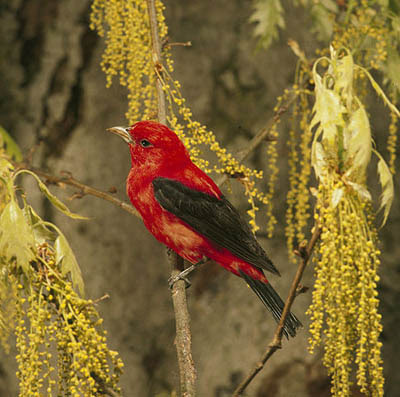 |
| Male Scarlet Tanager. USF&WS. Public Domain. |
Males are unmistakable with brilliant red with black wings and tail.
Females are olive-green above, darker wings and tail, yellower under parts. Pale bill.
These birds live in deciduous woods.
Scarlet Tanagers are summer residents throughout New York.
Common Redpoll
These frosty pink and red birds are northern relatives of the goldfinches.
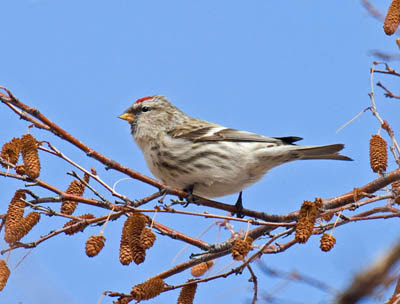 |
| Common Redpoll. Greg Gillson. |
These birds are frosty white in winter with brown striping above and on the sides. Both genders have red caps, black around bill and chin. Adult males have red upper breast. Immatures less red.
These birds are found in weedy fields and alder and birch trees in winter. Come to thistle feeders.
Common Redpolls are winter visitors in northern New York.
Orange birds of New York
True orange-colored birds are not that common. Many birds that I have here are paler rusty.
The common pattern is an orange body and black or brown wings and tail. Another common pattern is for the orange to be restricted to the under parts.
The following are orange birds that you are most likely to see in New York.
Barn Swallow
These orange-bellied birds are a familiar sight across North America in summer.
 |
| Barn Swallow. Greg Gillson. |
These birds are purple-blue above with orange under parts and long forked tails. The color of the underparts in winter or on females are often cinnamon or buff-colored, but breeding males can be brighter orange-red.
These birds swoop low over fields and wetlands at lower elevations. They may build their mud nests in rafters on porches, garages, or other out-buildings.
Barn Swallows are summer residents throughout New York.
Ruddy Duck
These small ducks are dark rusty-orange in spring.
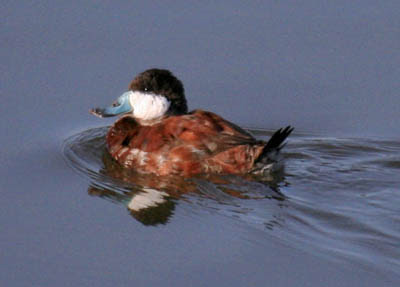 |
| Ruddy Duck. Greg Gillson. |
Males in breeding plumage (late winter and spring) are rusty, with a white face, and a blue bill. The long tail is often held sticking up. In winter they are brown, with white face, and dark bill.
Females all year are like winter males. Brown body, dark cap, dark line through eye of pale face. Dark bill.
These birds prefer weedy ponds to breed, but in winter may be found in deeper ponds in city parks.
Ruddy Ducks are spring and fall migrants throughout New York, summer residents in western and northwestern New York, winter visitors on Long Island area.
Eastern Towhee
These birds with rusty-orange sides like to hide in dense bushes.
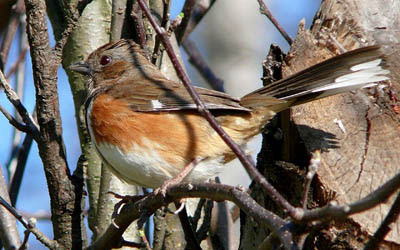 |
| Female Eastern Towhee. Skeeze. Pixabay. |
Males are black above with white wing patch, white tail corners. The sides are rusty. The belly white. Eyes variable: brown, red, orange, white, tending toward whiter southward.
Females are similar, but upper parts brown.
These birds are found in forest understory, dense brush, backyard hedges. Come to feeders.
Eastern Towhees are summer residents throughout most of New York, absent in mountains of northeastern New York, year-round residents in Long Island area.
Baltimore Oriole
These bright orange and black birds are fairly common breeders in wooded areas in the East.
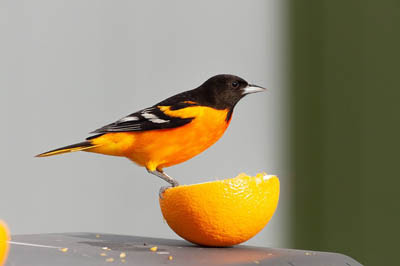 |
| Baltimore Oriole. Michael McGough. Pixabay. |
Males are have a black hood and back. Wings black with white patches. Tail black with orange sides to the base. Bright orange under parts.
Females are similar to males, but more olive above, less black. Immature birds for their first year or more are olive above orangish-yellow on the breast, fading to yellow on the belly. Two white wing bars.
These birds are common in deciduous woods, shade trees.
Baltimore Orioles are summer residents through much of New York, absent from higher mountains of northeastern New York.
American Redstart
In flight these small warblers flash orange or yellow in the wing and based of the tail.
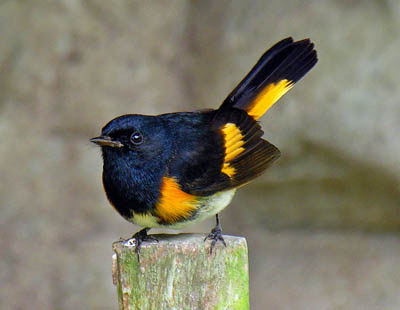 |
| American Redstart. Dennis Jarvis. Flikr. CC BY-SA 2.0 |
Males are black above, white on the belly. They have bright orange patches on side of breast, wings, and base of the tail.
Females are grayer, especially on the head. The orange of males is replaced by yellow on the females.
These birds are found in regenerating woods after a clear cut, and willow tangles along streams.
American Redstarts are summer residents throughout New York.
Red-breasted Nuthatch
These active little red-breasted birds crawls all around on the trunk and big branches of conifers. They search crevices in the bark for insect food.
 |
| Red-breasted Nuthatch. Greg Gillson. |
These tiny birds have blue-gray backs and a black line through a white face. Some males can have quite bright rusty red under parts. Some females can have quite pale buff-colored under parts. Most birds show an orange-cinnamon breast color.
Found nearly exclusively in conifers. Readily come to feeders.
Red-breasted Nuthatches are year-round residents throughout New York.
Wood Thrush
These spotted birds with the orange-brown upper parts tend to hide in understory trees and on the forest floor.
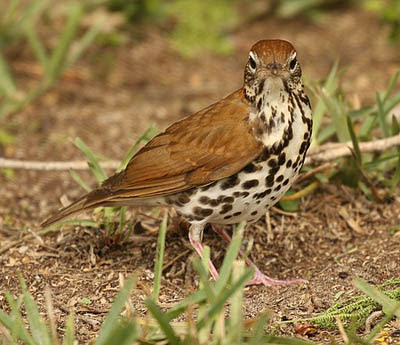 |
| Wood Thrush. Tony Castro. CC BY-SA 4.0 |
These birds are reddish brown on the upper parts, especially rusty orange on the crown and upper back. White eye ring. Large heavy black spots on the under parts.
They live in deciduous and mixed woods. Spend much time on the ground, shuffling through the leaf litter.
Wood Thrushes are summer residents throughout New York.
American Kestrel
These are the familiar small rusty-orange falcons sitting on power lines on the edge of the highway, or hunting and hovering over the median strip.
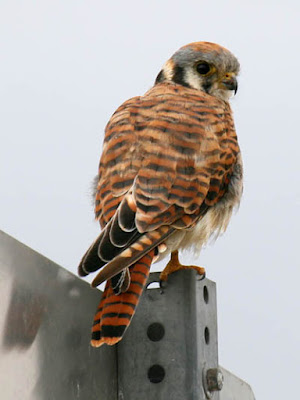 |
| Female American Kestrel. Greg Gillson. |
Females are rusty orange barred with black on their back wings and tail. The under parts are buff with black spots. The head shows two facial stripes.
Males have blue-gray backs and rufous tail is unmarked except for black tail band.
These birds are found in open country, farms, pastures with perches.
American Kestrels are year-round residents throughout most of New York, spring and fall migrants only in mountains of northeastern New York.
Brown Thrasher
These are rather large rusty-orange songbirds.
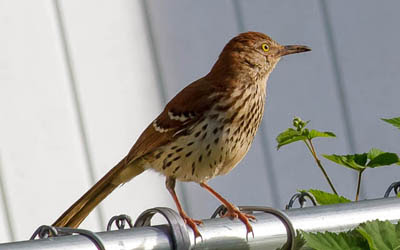 |
| Brown Thrasher. Linda Jones CC0. |
The upper parts of these birds is colored rusty-brown to orange. They show two white wing bars. Under parts are buff with heavy reddish-brown streaking.
These birds live in woodland edges and mature backyard landscaping.
Brown Thrashers are summer residents throughout New York, year-round residents in Long Island area.
Yellow birds of New York
Yellow is a common bird color! Often it is mixed with black and white plumage in birds.
Many birds with darker upper parts have yellow breast or belly.
The following are yellow birds you are most likely to see in New York.
American Goldfinch
These small little birds are bright yellow and black.
 |
| American Goldfinch. Greg Gillson. |
Males are bright lemon yellow with black and white wings and tail, black cap. White under tail coverts. Pink bill.
Females are duller yellow below and brownish above. Lack black cap.
Winter birds are pale brown or gray, a touch of yellow on the throat of males.
These are birds of open country, fields with saplings, clear cuts, residential areas. They avoid dense forests, mountains, deserts. They visit feeders.
American Goldfinches are year-round residents throughout New York.
Northern Flicker
These woodpeckers spend much time eating ants on the ground.
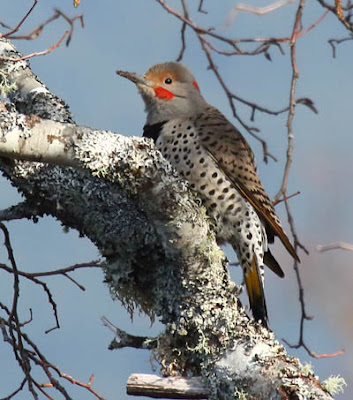 |
| Northern Flicker. Greg Gillson. |
These birds are larger than robins with brown and black barred upper parts. The underparts are pink with round black spots. There is a black crescent across the chest. When they fly away from you they reveal a large white rump.
Western birds have salmon-red under wings and under tail. Those in the East are colored yellow. The male face differs between the two populations–black whisker on the eastern birds, red whisker on western birds. Intergrades from overlap on Great Plains common. These may show male facial characteristics of both populations, or yellow-orange flight feathers.
These birds live in open woods with bare ground for foraging, residential yards.
Northern Flickers are year-round residents throughout much of New York, summer residents only in northern New York.
Common Yellowthroat
These buttery yellow birds are abundant in the marsh vegetation.
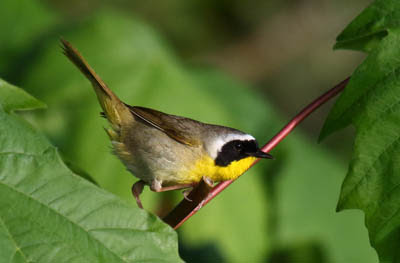 |
| Male Common Yellowthroat. Greg Gillson. |
These skulkers have bright yellow throats and yellow undertail coverts. Males have a black domino mask edged broadly in white, which females lack. Upperparts are dull olive-green.
Immature males in fall show a shadowed black mask.
Found in damp situations and heavy deciduous brambles following clear cuts.
Common Yellowthroats are summer residents throughout New York.
Yellow Warbler
The golden yellow sun packed all into one little bird! Appears to be an all-yellow bird.
 |
| Yellow Warbler. Greg Gillson. |
Some populations are bright yellow, some tend toward greenish on upper parts, some more golden. Yellow internal tail corners in flight.
Males with red breast streaking, again, variable by population.
Females somewhat to much paler yellow, some greenish, some whitish. Lack red streaks.
These birds are found in willow thickets on the edge of wetlands and ditches, stream sides in arid regions.
Yellow Warblers are summer residents throughout New York.
Cedar Waxwing
These crested birds with yellow band on the end of the tail are often found in flocks. They eat flying insects in summer, fruit and berries the rest of the year.
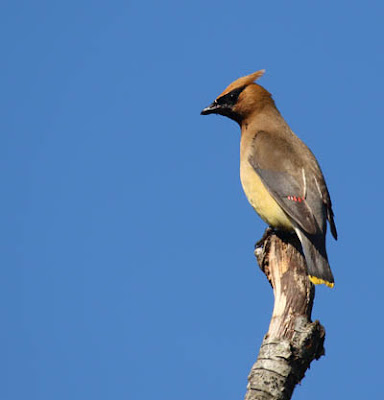 |
| Cedar Waxwing. Greg Gillson. |
These birds are fawn-brown above, with dark gray wings and tail. They have a black mask and wispy crest. The belly is yellow. The wings have waxy red drops on the end of the tertials. The end of the tail has a brilliant yellow tail band.
They are found in open habitats with berries, including juniper woodlands and towns in winter.
Cedar Waxwings are year-round residents throughout New York.
Yellow-rumped Warbler
These are abundant warblers across North America. Affectionately called “butter butts” by many birders, because of their bright yellow rumps that flash in flight.
 |
| Winter Yellow-rumped Warbler. Greg Gillson. |
Western form (Audubon’s) with bright yellow throat and yellow rump. Large white wing patch.
Northern and Eastern form (Myrtle) with white throat, yellow rump, and two white wing bars.
Winter birds are dull gray brown, with bright yellow rump. Throat may be cream colored or white. Often difficult to tell the two forms apart in winter.
Breed in mountain or boreal conifers. Widespread in migration. Winter in low river bottoms, open weedy deciduous areas. Rarely come to feeders in winter.
Yellow-rumped Warblers are summer residents throughout most of New York, winter visitors only in Long Island area.
Great Crested Flycatcher
These flycatchers have long tails and big heads with big bill and bright yellow belly.
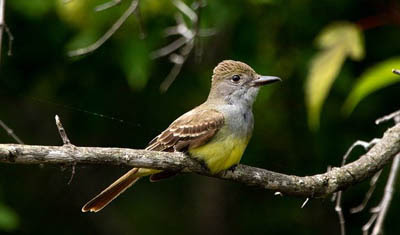 |
| Great Crested Flycatcher. Simard Francois. Pixabay. |
These birds are gray on the face and breast, brownish on rest of upper parts. Bright lemon yellow belly. The under side of the tail and some feathers of the wing are cinnamon colored.
These birds stay in the canopy of open woods.
Great Crested Flycatchers are summer residents throughout New York.
Magnolia Warbler
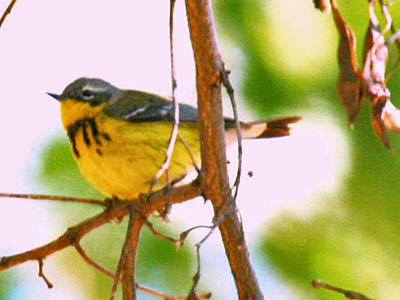 |
| Magnolia Warbler. Greg Gillson. |
Adult males are gray and black above and bright yellow below. Black mask and lower face. Gray crown. Black upper back. Black necklace that breaks into streaks down the breast. White under tail coverts. White under tail base, black terminal tail feathers. Large white wing patch.
Female with two wing bars, black mostly replaced with olive. Immatures for the first year lack black markings.
Live in moist coniferous forests, young stands of spruce and hemlock.
Magnolia Warblers are summer residents throughout New York.
Yellow-throated Vireo
Vireos are slow moving small birds that sing throughout the day. These yellow-headed vireos are one of the most colorful of their clan.
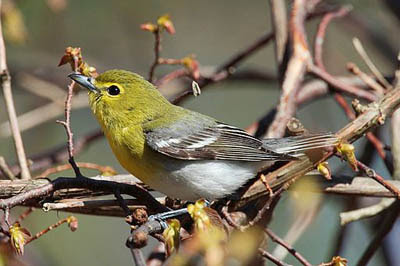 |
| Yellow-throated Vireo. MDF. CC BY-SA 3.0 |
These birds are blue-gray above, white below. Two white wing bars. Their head is olive yellow with yellow spectacles around the eye, and bright yellow throat.
These birds like large tracts of unbroken deciduous or mixed woodlands. Interestingly, however, they are often found on forest edges.
Yellow-throated Vireos are summer residents throughout New York.
Wrapping Up
New York State boasts a vibrant tapestry of colorful birds, adding splashes of beauty to its diverse landscapes. Here are some more of the most eye-catching feathered friends you might encounter:
Forests and Woodlands:
- Indigo Bunting: These small songbirds wear a captivating coat of deep blue during breeding season, while females and juveniles display more modest green coloration.
- Scarlet Tanager: Males flaunt a fiery red plumage with black wings and head, while females are dressed in greenish-yellow. Their vibrant colors make them stand out amidst the forest foliage.
- Eastern Bluebird: These sky-blue songsters, with their orange chests and white bellies, add a touch of elegance to woodlands and open spaces. Look for them perched on branches, singing their sweet melodies.
Open Fields and Meadows:
- Eastern Meadowlark: This grassland resident sports a striking yellow breast marked with a black V-shaped necklace, along with white outer tail feathers. Their bubbly song rings out across meadows and fields.
- Bobolink: Males impress with their black and white body patterns, including a white rump and buff neck collar. They sing while hovering in the air, creating a captivating aerial display.
- Red-winged Blackbird: These sleek blackbirds showcase prominent red epaulets on the males, adding a bold splash of color to open fields and marshes. Their loud “onk-la-lee” calls are a familiar sound of the countryside.
Waterways and Marshes:
- Wood Duck: This stunning duck boasts a kaleidoscope of colors, with iridescent greens, purples, and blues on the male’s head and neck. Females are less vibrantly colored but still quite beautiful.
- Great Egret: These elegant wading birds stand tall with their snowy white plumage and long, graceful legs. Look for them fishing in marshes and shallow waters.
- Belted Kingfisher: This vibrant predator sports a turquoise back, orange breast band, and white collar. Its large bill and loud rattle call make it a distinctive resident of waterways.
Frequently Asked Questions
There are several possibilities for birds with red heads in upstate New York, depending on the season and habitat:
Year-round residents:
- Red-headed Woodpecker: This medium-sized woodpecker has a bright red head covering its neck, throat, and upper breast, contrasting with its black back and white underparts. Both males and females have this striking feature.
- Northern Cardinal: The male cardinal, the state bird of New York, features a vibrant red head and chest with a black mask. Females have a more subdued coloration of brown and red.
Summer residents (April-October):
- Scarlet Tanager: Males boast a stunning scarlet plumage with black wings and head, while females are greenish-yellow. They frequent forests and woodlands.
- Summer Tanager: Similar to the Scarlet Tanager, males display a fiery red body with black wings and head, while females are olive-green. They favor wooded edges and parks.
- Baltimore Oriole: This dazzling songbird flashes deep orange on its body, contrasted with black head and white wing bars. They are commonly found in open woodlands and parks.
Migratory birds (present during different seasons):
- Red-breasted Nuthatch: This acrobatic climber sports a rusty red breast and gray body. They visit feeders and flit through trees throughout the year, but may be more evident in winter.
- Common Redpoll: These small finches arrive in winter and have a red patch on top of their head, along with brown streaking on their body. They frequent open fields and feeders.
What kind of bird has an orange head in NY?
There are several possibilities for birds with an orange head in New York, depending on the season and habitat:
Year-round residents:
- American Robin: The robin has a warm orange-red breast that contrasts beautifully with its gray back and white throat. Both males and females have this coloration, although males are typically brighter.
Summer residents (April-October):
- Baltimore Oriole: This flashy songbird boasts a deep orange body, black head, and white wing bars. Look for them in open woodlands and parks.
- Hooded Oriole: Less common than the Baltimore Oriole, this vibrant species showcases a bright orange head, black body, and white wing bars. They favor wooded edges and swampy areas.
- Common Yellowthroat: While primarily yellow, male Common Yellowthroats have a distinctive orange mask and bib surrounding their black heads. They frequent damp meadows and shrublands.
Migratory birds (present during different seasons):
- Black-throated Blue Warbler: Males of this warbler species sport a beautiful blue back and wings, along with a black throat and a bright orange crown. They frequent dense forests and woodlands during breeding season (May-July).
- Black-and-white Warbler: While not solely orange-headed, these warblers have a striking black and white striped pattern with bold orange patches on their head, wings, and tail. They visit woodlands and forest edges during migration (April-May and September-October).
- Orange-crowned Warbler: This rare migrant has a faint orange patch on its crown, along with gray and green plumage. They prefer coniferous forests in the northern parts of the state.
What is the difference between yellow warbler and goldfinch?
Both yellow warblers and American goldfinches are small, yellow songbirds, but there are several key differences to help you tell them apart:
Appearance:
- Color:
- Yellow Warbler: Brighter, purer yellow throughout, with no wing bars or streaks. Some males may have faint streaking on the breast.
- American Goldfinch: Yellow body with dark brown or olive wings and back, often showing wing bars. Males have a black cap and bib during breeding season.
- Bill:
- Yellow Warbler: Long, pointed bill, ideal for catching insects.
- American Goldfinch: Short, conical bill, perfect for cracking seeds.
- Size:
- Yellow Warbler: Slightly larger, about the size of a sparrow.
- American Goldfinch: Smaller and more compact, similar in size to a goldfinch.
Behavior:
- Habitat:
- Yellow Warbler: Prefers trees and shrubs in open areas like fields, parks, and wetlands.
- American Goldfinch: Found in grasslands, meadows, and open woodlands, often near feeders.
- Diet:
- Yellow Warbler: Insectivores, catching insects in mid-air or gleaning them from foliage.
- American Goldfinch: Primarily seed eaters, cracking seeds with their short, strong bills.
- Song:
- Yellow Warbler: Complex, high-pitched song with a buzzy quality.
- American Goldfinch: High-pitched, tinkling song, often described as a “per-chee-chee.”
Here’s a table summarizing the key differences:
| Feature | Yellow Warbler | American Goldfinch |
|---|---|---|
| Color | Bright yellow | Yellow with brown wings and back |
| Bill | Long and pointed | Short and conical |
| Size | Larger (sparrow-sized) | Smaller (goldfinch-sized) |
| Habitat | Trees and shrubs in open areas | Grasslands, meadows, open woodlands |
| Diet | Insects | Seeds |
| Song | Complex, high-pitched buzz | High-pitched, tinkling “per-chee-chee” |
Related Articles:
See photos and learn about the most common backyard birds in New York, regardless of color.
Learn about Birds at Your Feeder in New York
See photos and learn what to feed winter birds in New York.
Here’s a quick tutorial of how I would teach you to identify birds: 7 Steps to Identify Birds!
Birds with red heads in North America.
Yellow-and-black birds in North America.








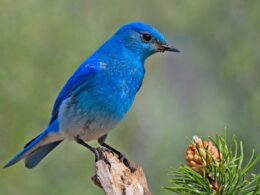

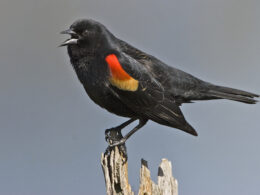
Great Pictures. Helped me identify two new visitors. Thanks again ~Dawn~
So wonderful to hear that, Dawn!